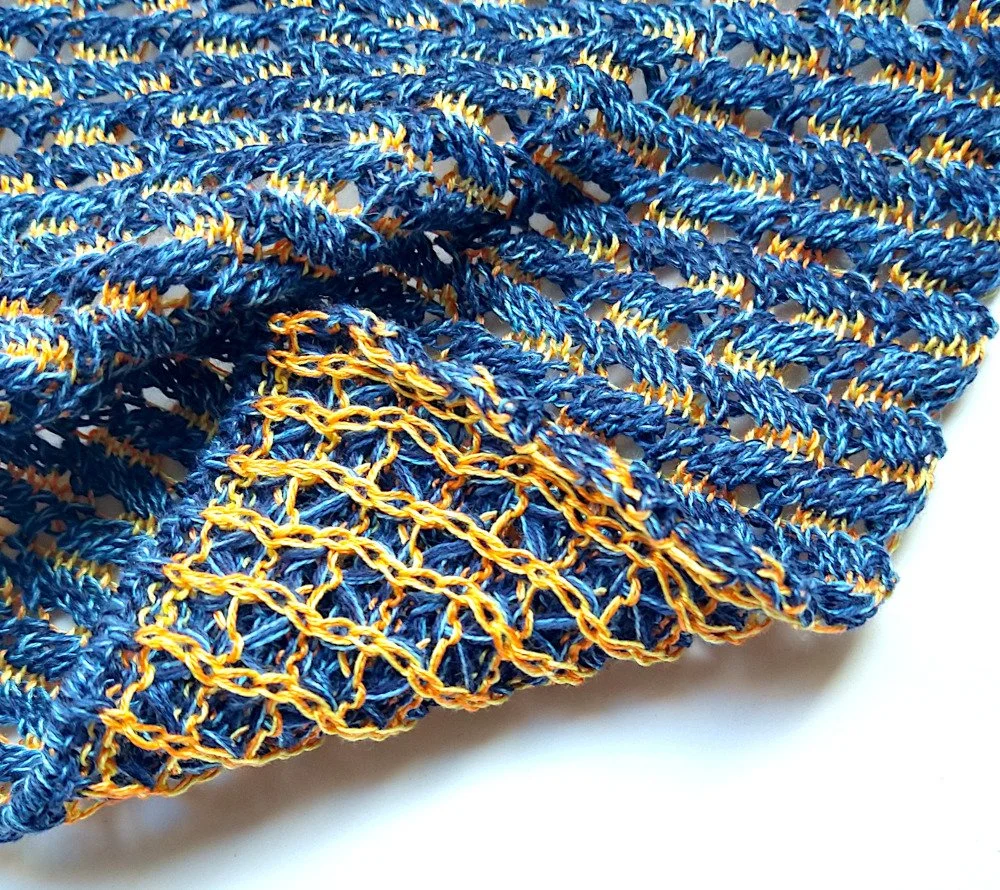Cotton vs Wool
Two swatches, same file, different look!
I’m always amazed at the way the look of a machine-knitted stitch pattern will change simply by switching out the yarns. Changing a yarn color can alter the fabric's "mood" or overall impact. Substituting a lightweight wool yarn for a heavier one can transform the look from elegant to casual. (A big change in yarn weight would most likely need to include a settings adjustment.)
The most significant differences in appearance and hand, I believe, result from a change in fiber (provided the stitch pattern has certain technical elements. I’ll get to those later.) In this case, I went from wool to cotton in a slightly lighter-weight yarn.
The cream and black wool swatch above is knitted with an NM 7.5 wool (approximately 3700 yards per pound). For the cotton swatch, the orange is approximately NM 8.5 (4200 ypp) and the blue is about NM 10 (a little over 5000 ypp). The two swatches were knitted using the same Kniterate .kc file, yet they look noticeably different.
Wool is stretchier than cotton
Once the wool swatch was off the machine, I allowed it to relax overnight and steamed it lightly before photographing it.
The cotton received the same treatment. It changed less in size after the rest and light steaming and remains nearly as wide as it was on the machine.
The yarns behaved in different ways on the machine, and each development has its unique properties. The cream wool is slightly ripply. There are tiny (two-row) rear-bed ripples in the file. The ripples are not apparent in the blue cotton, though they might show with a smaller stitch size for the orange. The cotton swatch has open spaces. The wool stretches more than cotton during knitting and later recovers, causing the lacy effect of this stitch pattern to nearly disappear.
Cotton, Linen, Rayon, and Silk vs Wool
It can be challenging to work with cotton and other relatively non-stretchy yarns if they are new to you. I always recommend that beginner machine knitters use wool for their first several swatches because wool is more forgiving and works well with a wider range of settings.
I’ve observed that the settings must be precise with cotton, linen, rayon, or silk, whether working with a Kniterate or another knitting machine. With yarn weights being equal, I recommend a larger stitch size for the non-stretchy yarns than would be used with wool. An alternative would be to use the same wool settings but with a non-stretchy yarn of lighter weight, if available, as I did in this #experiknit. I would love to hear about others’ experiences with cotton. (Contact me or DM me on Insta.)
Stitch Pattern
Not all stitch patterns will yield such different looks when going from one fiber to another. I would expect to see the most variability with patterns containing racking or openwork with transfers, the technical elements I was referring to earlier. A single racking stitch pattern with various fibers is shown below.
I love the versatility of racked stitch patterns. This past November I conducted a Racking Workshop. Several racked stitch patterns and ways to further develop them were presented. It was a pilot offering for Kniterate, Dubied, and domestic knitters. The participants’ wonderful feedback will influence the next offering of this workshop. If you’d like to be among the first to get information on the next Racking Workshop, please let me know.
O!
If you’re a Kniterate user, you may be interested in my prerecorded Designing with Kniterate classes. If you’re not an owner yet, I’d be happy to give you a virtual tour of the machine.




